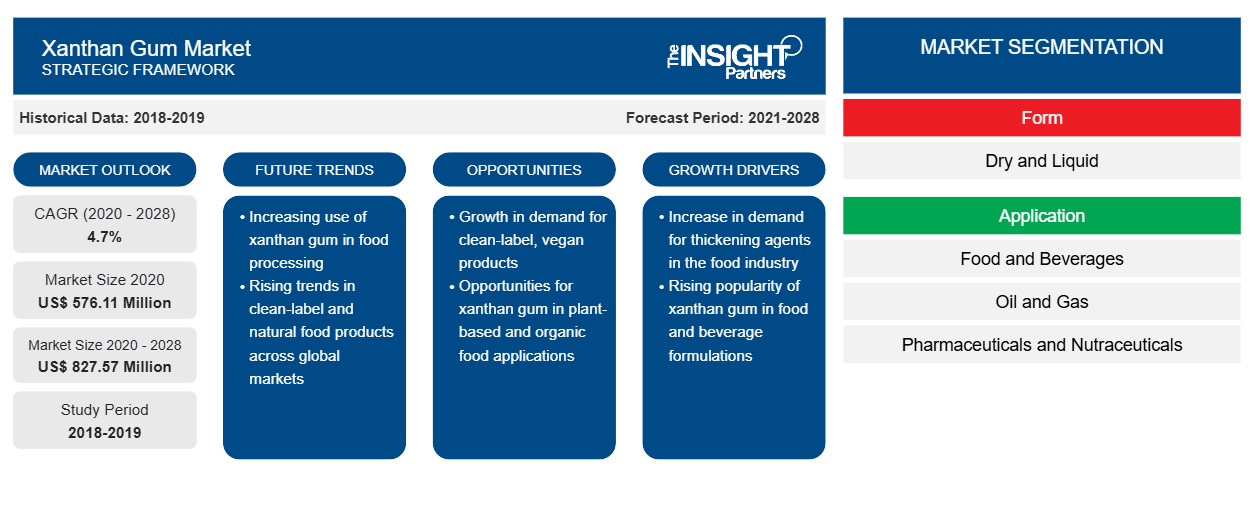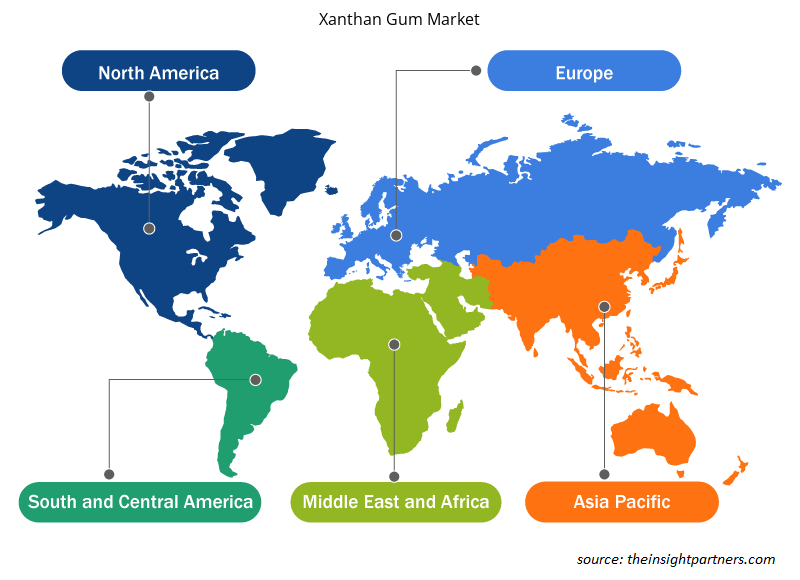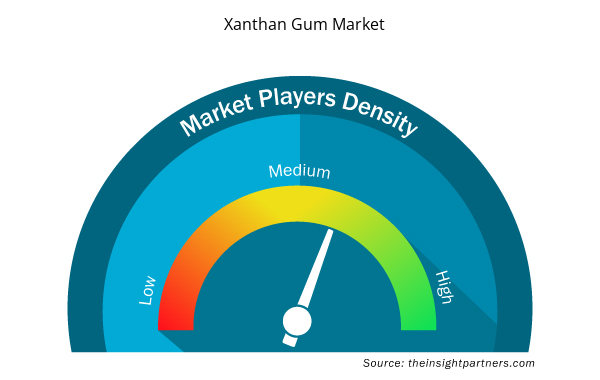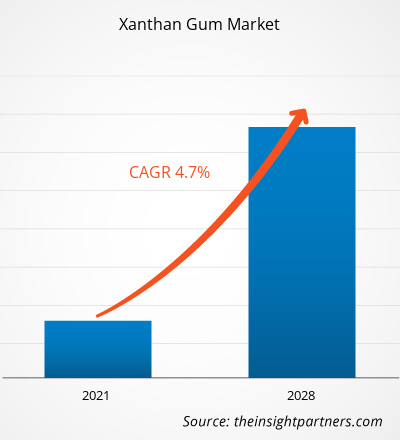[Research Report] The xanthan gum market was valued at US$ 576.11 million in 2020 and is projected to reach US$ 827.57 million by 2028; it is expected to grow at a CAGR of 4.7% from 2021 to 2028.
Xanthan gum is a polysaccharide used as an additive in products such as food and beverages, pharmaceuticals, personal care products, and others. It is synthetized by the bacteria Xanthomonas campestris through the fermentation process. When sugar is fermented, a fluid is produced, which is solidified by adding alcohol. After that, it is rinsed, pressed, and dried. It is generally available in two forms—dry and liquid. Xanthan gum enhances the viscosity of fluids. It is used as a stabilizer and thickening agent in different types of food and beverages, including bakery and confectionary products, beverages, sauces and dressings, dairy products, and ice creams. It is also used as a stabilizer and rheology modifier in personal care and pharmaceutical products. Moreover, it is used as a rheology modifier in the process of oil drilling and extraction. Xanthan gum also has various applications in the paints and pigments industries.
In 2020, Asia Pacific contributed to the largest share in the global xanthan gum market. The Asia-Pacific xanthan gum market is expected to grow at a notable CAGR during the forecast period owing to growing number of food and beverage processing plants in countries such as India, China, and Japan; emerging personal care and cosmetics industry in China and South Korea; and growing utilization in oilfield applications. Moreover, rising consumption of natural and processed food and beverage items; increasing demand for bakery and confectionary products in China, India, Australia, Malaysia, and Vietnam, among others; and growing health-consciousness among consumers are likely to propel the market growth in APAC in the coming years. Gluten-free bakery products are gaining high popularity across the region due to growing fitness trends.
Customize This Report To Suit Your Requirement
You will get customization on any report - free of charge - including parts of this report, or country-level analysis, Excel Data pack, as well as avail great offers and discounts for start-ups & universities
Xanthan Gum Market: Strategic Insights

- Get Top Key Market Trends of this report.This FREE sample will include data analysis, ranging from market trends to estimates and forecasts.
Customize This Report To Suit Your Requirement
You will get customization on any report - free of charge - including parts of this report, or country-level analysis, Excel Data pack, as well as avail great offers and discounts for start-ups & universities
Xanthan Gum Market: Strategic Insights

- Get Top Key Market Trends of this report.This FREE sample will include data analysis, ranging from market trends to estimates and forecasts.
Impact of COVID-19 Pandemic on Xanthan Gum Market
The COVID-19 pandemic has drastically affected the sales and overall operations of industries across different regions owing to lockdown imposed for prolonged periods, restrictions enforced on international trades, shutdown of manufacturing units, travel bans that led to supply chain disintegration, shortage of raw materials, and so on. The shutdown of food & beverages plants in leading regions such as North America, Europe, and Asia Pacific has affected the global supply chain and negatively impacted the manufacturing, delivery schedules, and sales of various food & beverage ingredients. Xanthan gum is one of the key ingredients in various convenience food products, such as bakery goods, frozen food products, dairy products, and ready-to-drink (RTD) beverages. Xanthan gum manufacturers witnessed low demand owing to decrease in the sales of comfort food products during the lockdown periods. Moreover, the COVID-19 crisis adversely affected the global beauty industry in the first half of 2020. This hindered the demand for xanthan gum from the personal care industry. However, businesses are gaining pace with the relaxation of previously imposed limitations in different countries. Moreover, the rapid rate of vaccination, owing to government and corporate support, is further easing the situation for industrial and commercial sectors.
Market Insights
Rise in Demand for Gluten-Free Food Products
Xanthan gum is a common food additive that is used as a gluten alternative. Gluten is a protein that gives wheat flour its structure. Xanthan gum is typically used with non-gluten-containing flour to produce gluten-free goods with good structure and texture. FDA and USDA regulatory standards limiting the amount of gluten in food products. For instance, according to the FDA's gluten-free food labeling rule, lower than 20 parts per million is the permissible limit of gluten in products labeled "gluten-free," "no gluten," "free of gluten," or "without gluten." Moreover, xanthan gum is a vital gluten-free baking ingredient that helps baked goods hold posture and develop elasticity. Among its common applications, including cakes and pancakes, cookies, muffins, quick bread, pizza dough, bread, and salad dressings, xanthan gum is often utilized in the making of pizza dough. The nutritional value of xanthan gum, which includes carbs and fiber, also increases its acceptability. In addition, xanthan gum is used in gluten-free products to improve the texture and shelf life. Like gluten, it also keeps baked goods moist and soft. However, gluten, which accounts for ~75% wheat, barley, and rye protein; it cause significant intestine damage and raise the risk of cardiovascular events in celiac disease patients. Hence, the growing prevalence of gluten-intolerance issues and other health-related problems caused due to gluten are highlighting the demand for gluten-free products.
Form Insights
Based on form, the xanthan gum market is segmented into dry and liquid. The dry segment accounted for a larger market share in 2020, and the liquid segment is expected to register a higher CAGR in the market during the forecast period. Dry xanthan gum disperses fast and forms a viscous, stable solution, when mixed with any liquid. As a result, it is an excellent thickening, suspending, and stabilizing ingredient. Moreover, xanthan gum powders are used in liquids to improve their viscosity, hydration, and clarity. Xanthan gum in dry form is soluble in, both, hot and cold liquids.
Application Insights
Based on application, the xanthan gum market is segmented into food & beverages, pharmaceutical & nutraceutical, personal care, oil & gas, and others. The food & beverage segment accounted for the largest market share in 2020, and the pharmaceutical & nutraceutical segment is expected to register the highest CAGR in the market during the forecast period. In addition to its stabilizing thickening properties, xanthan gum helps prevent oil separation, by stabilizing the emulsion in food products such as dressings and sauces. It is added to ice-creams and other frozen products to enhance their texture. In bakery and confectionery products, xanthan gum acts as a humectant, texture enhance, and viscosity builder Xanthan gum is a partial substitute to wheat flour as it acts as a binding agent. When employed in gluten-free baking, xanthan gum provides elasticity and stickiness to the dough and mixes. Gluten-free baked goods may lose their structure and texture if xanthan gum is not employed as a binder. Moreover, to achieve greater shelf stability, cellulose gum and xanthan gum are used most often as stabilizers in RTD beverages. Xanthan gum is also one of the key substitutes to gelatin, which is derived from animal source. The growing trend of veganism is driving the demand for plant-based food ingredients in the food & beverages industry.
A few players operating in the xanthan gum market are include ADM; Cargill, Incorporated; CP Kelco U.S., Inc.; Deosen; Fufeng Group; Hebei Xinhe Biochemical Co. Ltd.; Ingredion; Meihua Holdings Group Co. Ltd.; Solvay S.A.; and Unionchem. The major players are focused on strategies such as mergers and acquisitions, and research and development to increase the geographical presence and consumer base globally.
Report Spotlights
- Progressive industry trends in the xanthan gum market to help players develop effective long-term strategies
- Business growth strategies adopted by developed and developing markets
- Quantitative analysis of the xanthan gum market from 2019 to 2028
- Estimation of global demand for xanthan gum
- Porter’s five forces analysis to illustrate the efficacy of buyers and suppliers operating in the industry
- Recent developments to understand the competitive market scenario
- Market trends and outlook as well as factors driving and restraining the growth of the xanthan gum market
- Assistance in decision-making process by highlighting market strategies that underpin commercial interest, leading to the market growth
- The size of the xanthan gum market size at various nodes
- Detailed overview and segmentation of the market, as well as the xanthan gum industry dynamics
- Size of the xanthan gum market in various regions with promising growth opportunities
Xanthan Gum Market Regional Insights
The regional trends and factors influencing the Xanthan Gum Market throughout the forecast period have been thoroughly explained by the analysts at Insight Partners. This section also discusses Xanthan Gum Market segments and geography across North America, Europe, Asia Pacific, Middle East and Africa, and South and Central America.

- Get the Regional Specific Data for Xanthan Gum Market
Xanthan Gum Market Report Scope
| Report Attribute | Details |
|---|---|
| Market size in 2020 | US$ 576.11 Million |
| Market Size by 2028 | US$ 827.57 Million |
| Global CAGR (2020 - 2028) | 4.7% |
| Historical Data | 2018-2019 |
| Forecast period | 2021-2028 |
| Segments Covered |
By Form
|
| Regions and Countries Covered | North America
|
| Market leaders and key company profiles |
Xanthan Gum Market Players Density: Understanding Its Impact on Business Dynamics
The Xanthan Gum Market market is growing rapidly, driven by increasing end-user demand due to factors such as evolving consumer preferences, technological advancements, and greater awareness of the product's benefits. As demand rises, businesses are expanding their offerings, innovating to meet consumer needs, and capitalizing on emerging trends, which further fuels market growth.
Market players density refers to the distribution of firms or companies operating within a particular market or industry. It indicates how many competitors (market players) are present in a given market space relative to its size or total market value.
Major Companies operating in the Xanthan Gum Market are:
- The Archer-Daniels-Midland Company
- Cargill, Incorporated
- CP Kelco
- Deosen
- Fufeng Group
Disclaimer: The companies listed above are not ranked in any particular order.

- Get the Xanthan Gum Market top key players overview
Xanthan Gum Market – by Form
- Dry
- Liquid
Xanthan Gum Market – by Application
- Food & Beverages
- Pharmaceutical & Nutraceutical
- Personal Care
- Oil & Gas
- Others
Company Profiles
- ADM
- Cargill, Incorporated
- CP Kelco
- Deosen
- Fufeng Group
- Hebei Xinhe Biochemical Co. Ltd.
- Ingredion
- Meihua Holdings Group Co. Ltd.
- Solvay S.A.
- Unionchem
- Historical Analysis (2 Years), Base Year, Forecast (7 Years) with CAGR
- PEST and SWOT Analysis
- Market Size Value / Volume - Global, Regional, Country
- Industry and Competitive Landscape
- Excel Dataset



Report Coverage
Revenue forecast, Company Analysis, Industry landscape, Growth factors, and Trends

Segment Covered
Form and Application

Regional Scope
North America, Europe, Asia Pacific, Middle East & Africa, South & Central America

Country Scope
Argentina, Australia, Brazil, Canada, China, France, Germany, India, Italy, Japan, Mexico, Russian Federation, Saudi Arabia, South Africa, South Korea, United Arab Emirates, United Kingdom, United States
Trends and growth analysis reports related to Food and Beverages : READ MORE..
The List of Companies - Xanthan Gum Market
- The Archer-Daniels-Midland Company
- Cargill, Incorporated
- CP Kelco
- Deosen
- Fufeng Group
- Hebei Xinhe Biochemical Co. Ltd.
- Ingredion
- Meihua Holdings Group Co. Ltd.
- Solvay S.A.
- Unionchem

 Get Free Sample For
Get Free Sample For